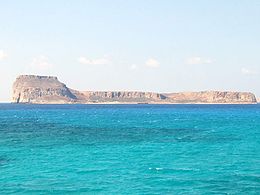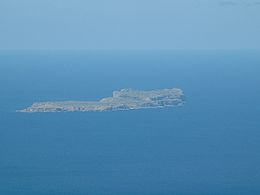Carabusa
| Native name: Ημερη Γραμβούσα | |
|---|---|

Imeri Gramvousa
|
|
| Geography | |
| Coordinates | 35°36′40″N 23°34′45″E / 35.61111°N 23.57917°E |
| Archipelago | Cretan Islands |
| Administration | |
|
Greece
|
|
| Region | Crete |
| Regional unit | Chania |
| Demographics | |
| Population | 0 |
| Native name: Αγρια Γραμβούσα | |
|---|---|

Agria Gramvousa
|
|
| Geography | |
| Coordinates | 35°38′30″N 23°35′10″E / 35.64167°N 23.58611°E |
| Archipelago | Cretan Islands |
| Administration | |
|
Greece
|
|
| Region | Crete |
| Regional unit | Chania |
| Demographics | |
| Population | 0 |
Gramvousa also Grampousa (Greek: Γραμβούσα or Γραμπούσα, further names include Akra, Cavo Buso, Cavo Bouza, Garabusa and Grabusa) refers to two small uninhabited islands off the coast of north-western Crete in the regional unit of Chania. They are administered from the municipality of Kissamos.
Imeri Gramvousa (Greek: Ήμερη Γραμβούσα), which translates to Tame Gramvousa, hosts the remains of a Venetian fort and the remains of buildings left behind by Cretan insurgents, who were compelled to live as pirates during the Greek War of Independence. Today, Imeri Gramvousa is a popular tourist attraction.
Agria Gramvousa (Greek: Άγρια Γραμβούσα), which translates to Wild Gramvousa, is much less hospitable and is located due north of Imeri Gramvousa. It has also been named False Gramvousa.
In ancient times the larger island was known as Korykos, which means leather bag. The island was name "Gramvousa" in honour of Vousa, the wife of a pirate chief and the only inhabitant of the island to evade capture when the pirates were forcibly removed.
The fort at Imeri Gramvousa was built between 1579 and 1584 during Venetian rule over Crete to defend the island from the Ottoman Turks. The fort remained in Venetian hands throughout the prolonged Cretan War, and in the treaty of 16 September 1669, which surrendered Crete to the Ottomans, Gramvousa, along with the fortresses of Souda and Spinalonga, was retained by Venice. These three forts defended Venetian trade routes and were also strategic bases in the event of a new Ottoman–Venetian war for Crete.
On 6 December 1691, during the Morean War (another Ottoman–Venetian war), the Neapolitan Captain de la Giocca betrayed the Venetians by surrendering Gramvousa to the Ottoman Turks for a generous bribe. He lived the rest of his life in Constantinople and was well known by the nickname "Captain Grambousas". Not long after the start of Turkish rule, Cretan insurgents used to gather at the three coastal forts which included Gramvousa.
...
Wikipedia
